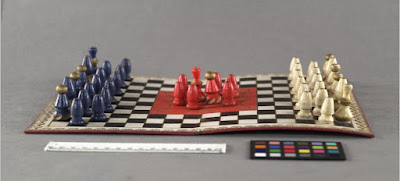The Siege of Paris
Here the initial setup:
and a better view of the board (from BoardGameGeek):
Also, at Oxford Digital Library, here the scan of the original rules:
At BoardGameGeek there's also the rules in text format:
The Siege of Paris
The positions of the Men are as follows :- The General on the right, the Colonel on the left, the Captains next,and the Lieutenants in the centre ; the placing of the Men in the Garrison is optional.
RULES OF THE GAME
1.-The Besieging party have 36 Men,viz., two Generals two Colonels, four Captains, four Lieutenants. to be equally divided, and to be in two colors, half to move on the Black Squares, and half on the White.
2.-The Besiegers cannot move backwards, Officers or Men.
THE MOVES OF THE BESIEGING PARTY
3.-The Generals move on White or Black Squares-one, two or three Squares at a time. straight, sideways and diagonally.
4.-The Colonel moves on White and Black Squares-one or two squares at a time, straight or sideways.
5.-The Captain moves on White or Black Squares-one square at a time, straight or sideways.
6.-The Lieutenants move diagonally-one or two Squares at a time.
7.-The Men move only diagonally whichever Square they are placed on.
8.-The Besieging party win the game by placing one Officer and three Men in the Garrison, and cannot be taken when inside.
RULES FOR THE GARRISON MEN
9.-The Garrison is occupied by eight Men, viz., one General, one Colonel and six Men, and win the game by taking 24 Men and six Officers.
10.-The Officers and Men of the Garrison cannot be taken, but the Men can be blocked in by the Besieging party, until they are relieved by their Officers.
11.-You are not compelled to take any Man; when any of the Besieging party are taken they must be unsupported, and place your man on the same Square.
12.-The Officers and Men of the Garrison to be Red.
MOVES OF THE GARRISON MEN
13.-The General can move any way-backwards or forwards, straight, sideways or diagonally, and take the same way one or two Squares at a time, either on Black orWhite Squares;
the Colonel moves on Black or White Squares, backwards or forwards, either sideways or straight, and takes the same way;
the Men move diagonally only, three on the white Squares and three on the Black, either backwards or forwards when outside the Garrison
Entered at Stationers' Hall
R.C.Bell provided a patch for solving some problems with the original rules (from BoardGameGeek):
Necessary additional rules and definitions for Siege of Paris. V1.0 May 2009
Win conditions
Garrison player: Capture 6 Besieging Officers and all Besieging Men.
Besieging Player: Having 1 Officer and 3 Men inside the Garrison. (Besieging pieces can not be taken once inside the Garrison.)
Or by blocking with Besieging pieces all legal moves by the Garrison forces. (Supported Besieging pieces can not be captured.)
Alternative win condition for Besieging Player: 1 Officer and 2 Men inside the Garrison.
Draw condition
When less than the pieces required for the chosen win condition remain on the board, then if 1 Besieging piece, or more, are inside the Garrison the game is a draw.
Starting position of Garrison pieces: These pieces may be arranged on the nodes inside the Garrison however the Garrison player wishes.
Turn order: Garrison, White, Garrison, Black, Garrison, White, ...
Alternative forced taking rule: The Besieging player can, if such a move is legal, command the Garrison player to take a Besieging piece.
Fort Gate: Entry to the fort is from the 2 squares (1 black square and 1 white) adjacent to the gates on each side of the fort.
Support: Besieging piece "A" is "supported" when another Besieging piece could legally move onto the square occupied by "A" but for the presence of "A". (Supported Besieging pieces can not be captured.)
Capture: As in chess, by moving the capturing Garrison piece onto the square occupied by the Besieging piece. (Garrison pieces can not be captured.)
---
More information at Jeux Strategie.




No comments:
Post a Comment